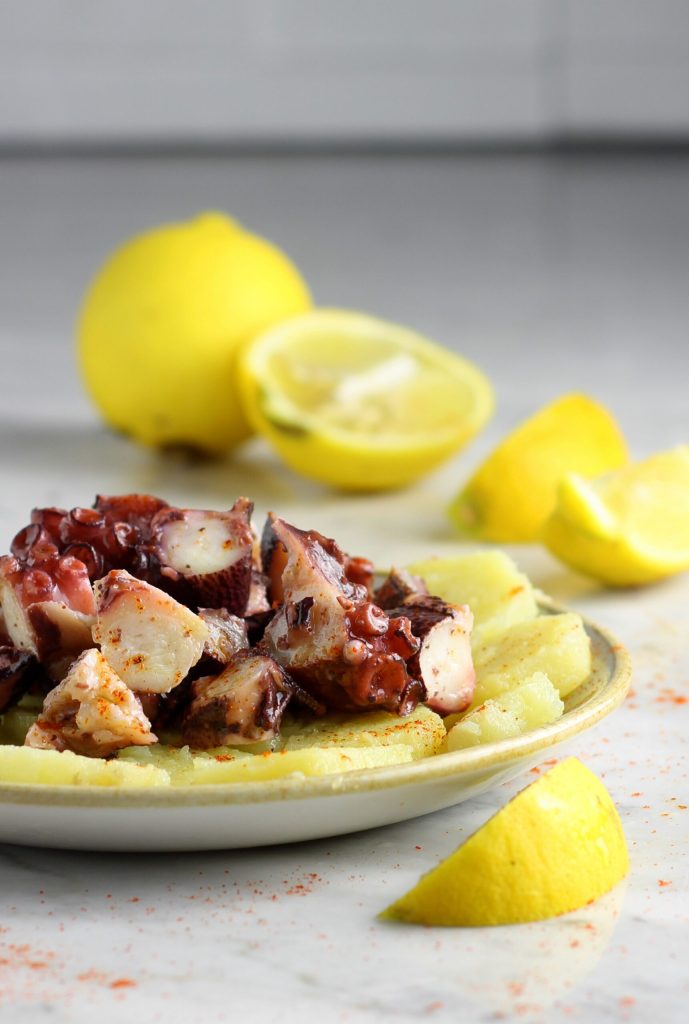Galician-Style Octopus in Pressure Cooker is a traditional Spanish recipe that satisfies all tastes: a warm dish in winter and a cold dish in summer. The result is always the same: delicious. Spaniards usually enjoy it as Tapas, that is, as an appetizer, combined with other tastings before an important course, or just as one of the many snacks, during a wine or beer aperitif. I prefer to consider it a proper main course, simple and impressive, that everyone always likes. You can reduce the cooking time if you use the pressure cooker, as in this case, and a nicely cleaned octopus from your trusted fishmonger. If you plan to buy a frozen one, no problem, but make sure it’s of excellent quality. You will have to wait for it to thaw, and always do it in the refrigerator, but the result will still be perfect.
To make it more fragrant, I added a personal touch by mincing with a knife a clove of preserved confit lemons, which I never miss having.
For those unfamiliar with the pressure cooker and want to try it safely, I leave the link to my article below, along with those of other octopus-based recipes

- Cost: Medium
- Preparation time: 10 Minutes
- Portions: 4 people
- Cooking methods: Pressure Cooker
- Cuisine: Spanish
- Seasonality: All Seasons
Ingredients
- 2.6 lbs octopus
- 6 potatoes
- 2 onions
- to taste salt and pepper
- 4 tbsps extra virgin olive oil
- to taste spicy paprika
- 1 bunch parsley
Tools
- 1 Pressure Cooker
Preparation
Place the Octopus inside a pressure cooker, if already cleaned by our fishmonger, or after removing the beak, the innards, and washed.
Add the onion and enough water to cover it well.
Adjust with salt and close tightly with the lid.
Lower the valve and cook on high flame until the strong whistle sounds.
At this point, lower it to the minimum and cook for about 20 minutes.
Before opening, let the pot cool down, since you will also need the octopus cold.
If we decide to cook it with the traditional method, it will take from 50 to 60 minutes.
Meanwhile, if we have more than one pressure cooker, we can proceed with the potatoes.
Place them inside, cover with water, close with the lid, and make sure the valve is closed.
Use the same procedure as the Octopus, but calculate only 10 minutes of cooking. If the potatoes are small, 6/7 minutes will suffice.
In this case, so that the potatoes do not continue to cook, from the moment we have turned off, wait 5 minutes and then release the steam by opening the valve.
But do it slowly, in such a way that the steam contained therein is released little by little.
Once the potatoes are cold, cut them into slices or half moons, but make sure they are at least 0.4 inches thick.
Place them in a bowl and season with extra virgin olive oil, salt, chopped parsley, and mix well.
Prepare the octopus in the same way as the potatoes.
Now that all the ingredients are ready, we can assemble the dish. Arrange the potatoes on a serving dish to form a layer, and place the octopus on top.
Sprinkle it with sweet paprika and chopped parsley.
Another drizzle of oil, and if you like it, some pieces of fresh lemon zest or, in this case, pieces of preserved confit lemon.
Serve our Galician-Style Octopus in Pressure Cooker, hot or at room temperature if it is winter, or cold, maybe even from the refrigerator, if it is summer.
Advice and Storage
The Octopus cooked this way will keep perfectly for one or two days in the refrigerator, but place it inside an airtight container.
As always, I recommend using glass or ceramic, because plastic is harmful.
As always, I recommend using glass or ceramic, because plastic is harmful.
As always, I recommend using glass or ceramic, because plastic is harmful.

